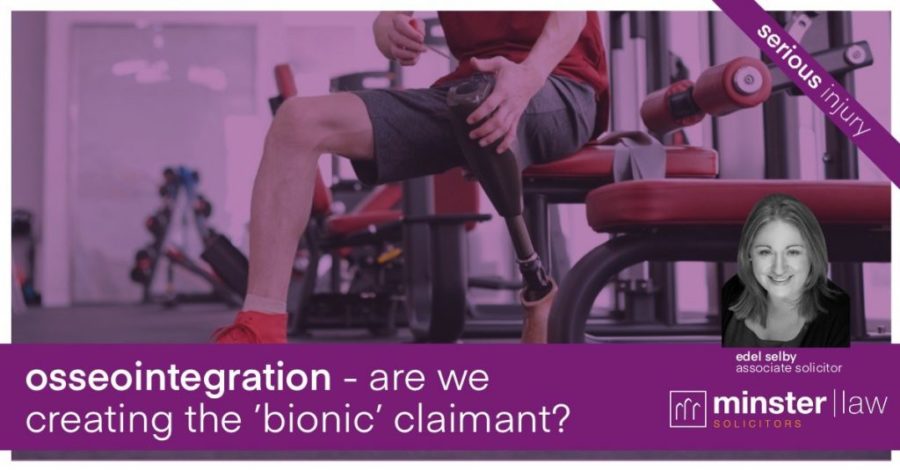Osseointegration- are we creating the ‘bionic’ Claimant?


Minster Law associate solicitor Edel Selby explores the surgical method, Osseointegration, as an alternative to traditional socket prosthesis for amputees.
Osseointegration is a surgical method which introduces metal into bone with the purpose of achieving permanent bonding between them.
This method is widely used in dentistry for implanting/replacing missing teeth, joint replacement surgeries and more recently in amputees as well.
Osseointegration in amputees is an alternative method of attaching a prosthesis to an amputee’s body and involves a titanium rod being inserted directly into the bone – this process eliminates the need for a traditional socket.
As anyone who works with amputees will attest, despite everyone’s best efforts socket problems can often one the biggest barriers for successful long-term prosthetic use.
The surgery was originally developed in the 1990s by Professor Branemark in Sweden but has been significantly developed in recent years to the point that it is now a genuine and viable option for most upper and lower amputees.
Various surgical centres located around the world including Australia, Germany, the Netherlands, Sweden and the United States now offer the procedure.
While osseointegration is not currently available in the UK on the NHS, there are several private centres who will currently perform it.
With increased knowledge and events such as the Invictus Games there has been an increase in the number of amputees considering, and ultimately opting for, the surgery.
There are restrictions on those who are deemed suitable for the surgery as it is complicated and intrusive surgery.
It is generally deemed suitable for those that have reached full skeletal maturity, people aged 20 to 69, and those people that are not satisfied with or having problems with traditional socket technology.
It is significant surgery which naturally carries not insignificant risks.
Most centres across the world will only consider osseointegration for amputees with a body mass of less than 100kgs, people who are non-smokers, with no history of osteoporosis.
Before definitive pre-operative preparation and in addition to all the physical checks, all potential patients will be reviewed extensively by a psychologist.
The psychologist will pay particular attention to investigate any potential hidden psychological conditions.
Some of the most prevalent can be patients who may either underestimate the consequences or overestimate the benefits of the osseointegration procedure.
Different surgeons at different centres take their own approach to surgery.
Some perform the surgery in a two-step procedure whilst others complete it in one operation.
Pre- and post-operatively, patients will need be seen regularly by a physiotherapist experienced with osseointegration procedures.
The length of the residual bone stump links directly with the functional outcome.
Generally speaking, the longer, the stump of bone, the better the function of the prosthetic limb can be expected.
So, if the stump is very short Claimants will have to anticipate that the function of the limb post osseointegration will be decreased although it should be better than before the surgery.
As with any surgery, the risk of infection is the biggest threat.
Infection is likely to be the main reason why the procedure may fail.
Another potential post-surgical problem is fracture.
The bone is usually weakened by disuse over a long period of time, because of the injury.
Fixing a fracture post osseointegration can be challenging because the majority of the bone is likely to be covered by the osseointegration stem, leaving few options for repair of the fracture.
Additionally, there are significant risk of issues related to the stoma (which is the term used to refer to the opening of the skin where the implant comes through), which can cause a lot of pain and discomfort.
Usually they can be treated with antibiotics, and regular stoma care alleviating the symptoms can reduce this.
Clinically, patients will be followed up at least 6 weeks, and then after 3 months, 6 months and 12 months postoperatively.
Most who consider such surgery do so because they are seeking improved comfort and/or increased functionality.
Generally speaking, but not always, most Claimants will have experienced considerable problems with socket fitting and/or skin breakdown around the stump before embarking down the road of osseointegration.
It is, however, not a decision to be taken lightly.
There have been approximately 3,000 amputees that have undergone the surgery since the 1970’s and there have been numerous reported problems, such as infection and soft tissue irritation at the stoma, fractures, fatigue of metal, issues with the prosthetic connectors and loosening of the implant.
In dentistry, where osseointegration is commonplace, bringing the implant through the gum does not represent a major problem due to the very limited mobility of the gum around the osseointegrated implant, which permits the gum to adhere to the implant quickly and securely.
Unfortunately, this is not the case for amputees because the skin and muscles on the stump will move during movement of the stump, while walking, exercising, and so on, causing irritation in the transition zone and in more extreme cases the stoma.
The costs of the surgery varies according to where it is carried out.
However, it is usually in the region of £60,000 to £100,000 for the surgery alone, depending on complexity and the team/country where the surgery is likely to take place.
The interface components typically cost in the region of £4,000 – £5,000 and need to be replaced approximately every 2-3 years. In addition, there is the cost of the aftercare and rehabilitation.
During the claims process a candidate for osseointegration is likely to have a rehabilitation package overseen by a Case Manager with experience in amputation claims.
Once the decision has been made for osseointegration, steps will be taken for the Claimant to attend an osseointegration provider for a full assessment, including costs.
More and more we see that Defendants are not averse to a Claimant opting for osseointegration but understandably they will need to see evidence that it is the right and appropriate option in an individual case.
There can in fact be a financial saving to a Defendant when compared to costings for traditional socket-base mouldings which sometimes have to be altered every few years.
It is difficult to say.
The future remains unclear regarding osseointegration, but the changes in implant design, surgical technique, pre- and post-surgery care and rehabilitation protocols have resulted in improvements of functional outcomes and quality of life.
From the limited available research, it also appears that as techniques develop and information is shared there has been a reduction in complications post-surgery.
It is now largely considered that for some amputees the benefits of osseointegration outweigh the acceptable clinical risks and it is becoming an established clinical treatment for those struggling with traditional socket prosthesis.
It is certainly something to be considered and discussed for an amputee struggling with traditional socket prosthesis.